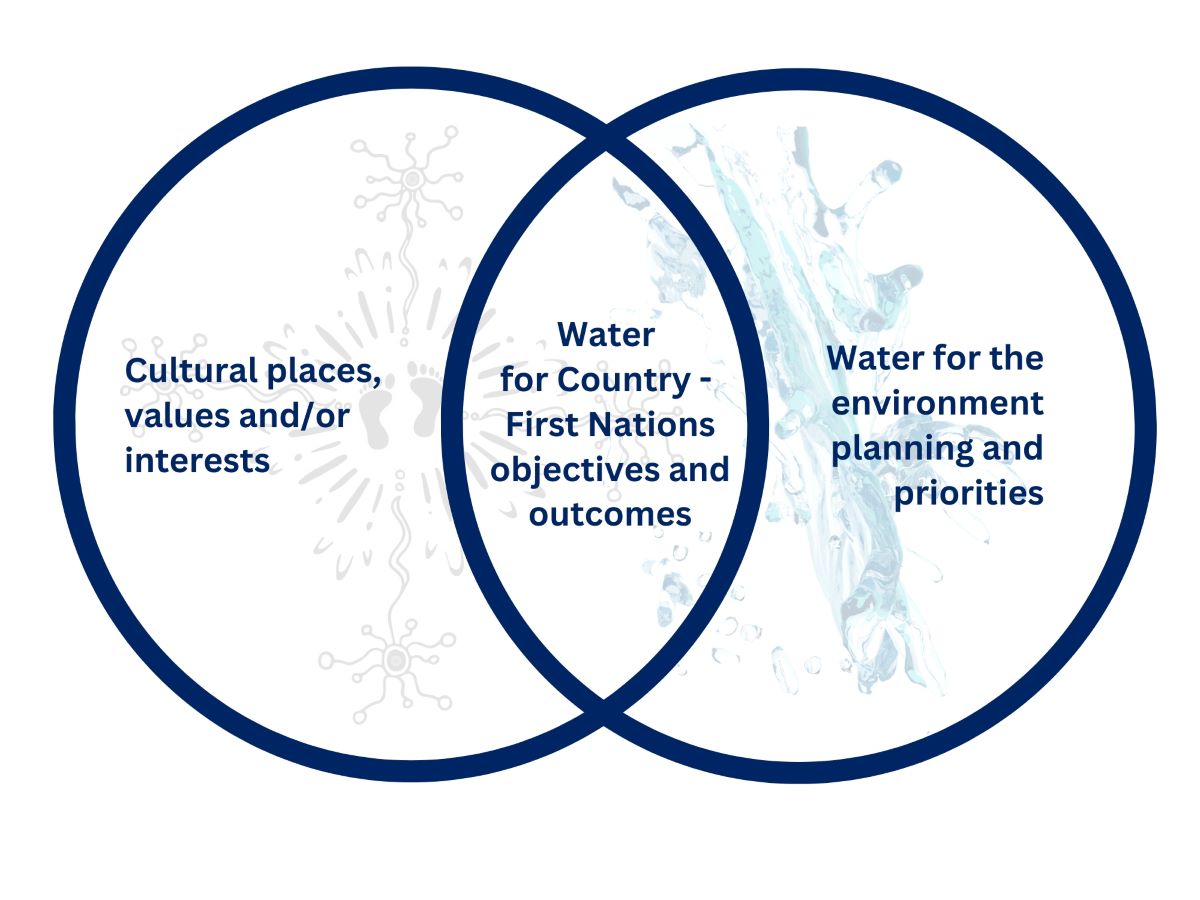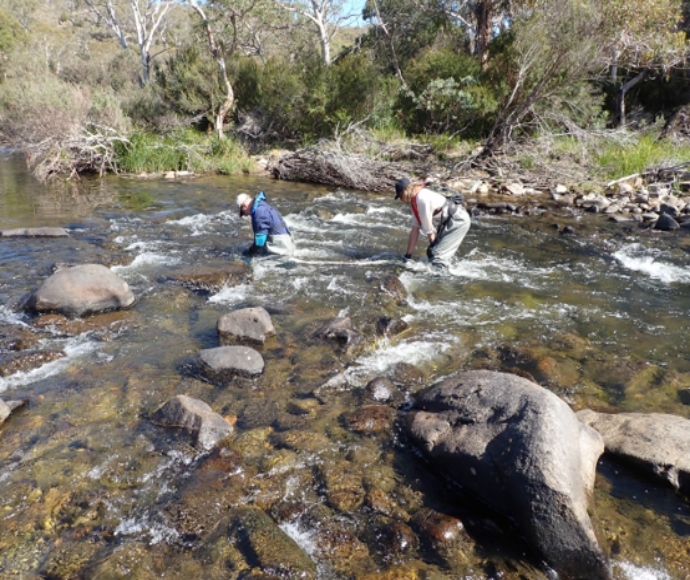The Snowy River headwaters lie next to those of the Murray and Murrumbidgee rivers, together forming the alpine, subalpine and mountain catchments of these major rivers of south-east Australia. These rivers flow from Kosciuszko National Park, the largest national park in New South Wales.
The Snowy and Snowy montane rivers and tributaries have been diverted in full or part for hydro-electricity generation and irrigation purposes. The Snowy montane rivers include the upper Murrumbidgee, the upper Snowy, the Geehi and the Goodradigbee rivers.
The NSW portion of the Snowy catchment area is 9,070 square kilometres. The upper Murrumbidgee catchment covers 14,000 square kilometres of New South Wales and the Australian Capital Territory.
Water for rivers and wetlands
In 2023–24, environmental water managers will continue to build on the outcomes of previous years to improve the health of the Snowy and Snowy montane rivers.
The Department of Planning and Environment worked with the Snowy Advisory Committee (SAC) and ecological experts to design planned releases for the Snowy rivers. Daily releases are planned prior to the start of the water year (that is, May to April) for the 12 months ahead. A ‘natural flow scaling’ approach is applied by using the Thredbo River as a reference. Water managers use historical flow data from the Thredbo River as a basis for designing releases each year for the Snowy. The Thredbo River is a similar size snowmelt river to the modified Snowy River below Jindabyne.
The focus for 2023–24 is to improve the condition of the Snowy River channel by providing a series of high flows and five 8-hour peaks to mobilise sediment that has built up in the riverbed and assist in returning the Snowy River to a healthy, albeit smaller, river.
The pattern for releases for the Snowy and upper Murrumbidgee rivers includes higher flow rates over winter, spring, and early summer to reflect flow patterns typical of the mixed rainfall and snowmelt river system.
During 2022–23, the department worked with Snowy Hydro Limited to deliver 209,877 megalitres of Snowy River Increased Flows and 79,900 megalitres of Snowy Montane Rivers Increased Flows to the Snowy montane rivers.
Aboriginal water management priorities
Water for Country is environmental water use planned by the department with Aboriginal peoples to achieve shared benefits for the environment and cultural places, values and/or interests.
The figure below illustrates how environmental water can lead to co-benefits for cultural and environmental outcomes.

Environmental water managers have been working to support Aboriginal people’s priorities in water management.
In 2023, the Ngunnawal people completed the Aboriginal Waterways Assessment (AWA) in the upper Murrumbidgee. AWAs assist Aboriginal peoples to collate traditional knowledge about their significant waterways, and environmental and cultural values. The AWA process involves Aboriginal peoples going out on Country and assessing chosen sites based on cultural significance and environmental health.
In 2023–24, we hope to:
- continue to build local and regional relationships with Aboriginal peoples
- support Aboriginal representatives to include their priorities in SAC discussions
- complete a video of the AWA process on the upper Murrumbidgee.
Weather and water forecast
In early July, the El Niño–Southern Oscillation (ENSO) outlook remains at El Niño alert. ENSO is the interaction between the sea surface and the atmosphere over the Pacific Ocean which results in drier (El Niño) or wetter (La Niña) conditions.
This means there is now a 70% chance that an El Niño may develop later in 2023. El Niño typically brings hot, dry conditions to Australia. The Bureau of Meteorology’s seasonal outlook for autumn indicates that rainfall is likely to be below average across much of the catchment.
The wet conditions of the previous year have provided 220,500 megalitres of water for the environment, which is available for the Snowy River in the 2023–24 water year. A foregone electricity generation of 150 gigawatt hours (GWh) is available for the Snowy montane streams, which is the equivalent of 52,000 megalitres for the Snowy montane streams and 40,757 megalitres for the upper Murrumbidgee River. There is sufficient environmental water allocation to deliver water to all the targeted Snowy montane streams. Water is delivered to the Snowy montane streams by closing the aqueducts that were designed to divert water to storage dams, allowing water to overtop the weirs and continue to flow freely.
Resource availability scenario
Current forecast: Moderate to wet
| Forecast | Main aim | Other aims |
|---|---|---|
| Very dry | Protect | Avoid critical loss Maintain key refuges Avoid catastrophic events |
| Dry | Maintain | Maintain river functioning Maintain key functions of high priority wetlands |
| Moderate | Recover | Improve ecological health and resilience Improve opportunities for plants and animals to breed, move and thrive |
| Wet to very wet | Enhance | Restore key floodplain and wetland linkages Enhance opportunities for plants and animals to breed, move and thrive |
Key planned actions for 2023–24
Geomorphology
Flows aim to improve Snowy River channel condition by providing 5 high-flow events with 8-hour peaks. These high-flow events will increase stream power (flow velocity) to flush fine sediment from the stream bed, reduce algae-smothering and clean riffles.
Native fish
Flows will be delivered to support native fish breeding and dispersal in the Snowy and Snowy montane rivers. Higher releases in winter and spring to the upper Murrumbidgee River will encourage spawning and movement for the endangered Macquarie perch. The upper Murrumbidgee supports one of only 3 remaining natural populations of the perch species in New South Wales.
Native vegetation
Releases will promote recruitment of aquatic native vegetation in low benches connected ponds, wetlands, and backwaters that support water-dependent animals, including platypus and frogs. Multiple high releases into the Snowy River will also help to limit the encroachment of terrestrial plants in the riverbed.
Native animals
Planned releases will support a diversity of suitable habitats for water-dependent animals, including macroinvertebrates, frogs, platypus and turtles, by increasing resource availability and productivity and providing opportunities for breeding and recruitment. Inundation of connected wetlands and ponds will provide breeding opportunities for frog species.
The Department of Planning and Environment is supporting the health and resilience of alpine and subalpine rivers by delivering water for the environment to the Snowy montane rivers. We use the best available science, management expertise and experience to manage environmental water across the landscape. This statement of annual priorities identifies the planned releases for waterways.
Our decision-making process considers:
- availability of water in the coming year
- daily releases and conditions of the previous year
- current health of native plants and animals in these ecosystems.
The SAC provides feedback and advice to the department on the management of water for the environment.
Water for the environment is a share of the water in dams and rivers that is set aside to support the long-term health of local rivers, creeks and wetlands. Healthy rivers carry water to homes, farms, schools and businesses. Rivers and wetlands are important cultural and spiritual sites for Aboriginal people, as well as the broader community.
Table 1 Summary of annual water allocation availability for the Snowy River for 2023–24
| Water account | Annual volume (ML) |
|---|---|
| Snowy River increased flows | 212,000 |
| Base passing flow – Jindabyne | 8,500 |
| Under delivery use | 56 |
| Total | 220,556 |
Table 2 Snowy montane rivers increased flows allocations and settings for the 2023–24 water year
| River reach/catchment | Modified works | Conversion factor (GWh per GL) | Forgone electricity generation (GWh) | 2023–24 volume (GL) |
|---|---|---|---|---|
| Murrumbidgee River | Tantangara Dam outlet | 1.94 | 79.1 | 40.8 |
| Goodradigbee River | Goodradigbee River Weir | 1.94 | 13.6 | 7 |
| Geehi River | Middle Creek Weir | 1.85 | 32.4 | 17.5 |
| Geehi River | Strzelecki Creek Weir | 1.85 | 9.6 | 5.2 |
| Snowy River – Island Bend to Lake Jindabyne | Tolbar Creek Weir | 0.71 | 6.7 | 9.5 |
| Snowy River – Island Bend to Lake Jindabyne | Diggers Creek Weir | 0.71 | 6.7 | 9.4 |
| Snowy River – Guthega to Island Bend | Falls Creek Weir | 0.57 | 1.9 | 3.4 |
| Total | – | – | 150 | 92.8 |
Notes: GL = gigalitres; GWh = gigawatt hours; ML = megalitre. 2.5 megalitres = 1 Olympic swimming pool.
This is an indicative summary of expected volumes to be available. For further detail and information on available volumes, please contact the region by phoning Department of Climate Change, Energy, the Environment and Water enquiries on 1300 361 967.

The NSW portion of the Snowy catchment area is 9,070 square kilometres.